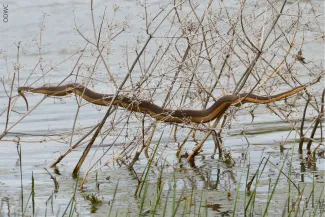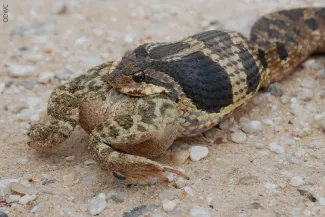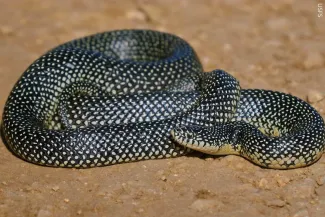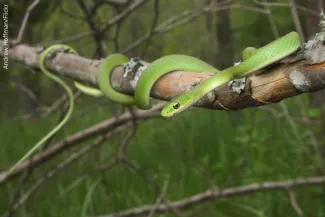Love ‘em or hate ‘em, snakes are a natural part of our landscape – and provide a wealth of ecosystem services. Larger snakes are well known for their help in rodent control and smaller snakes like ring-necked snakes are efficient insect hunters. Snakes play a reverse role in the food chain as well – many species of birds and mammals find snakes to be a tasty meal. To give snakes the credit they deserve, we polled Wildlife Diversity Program biologists for their all-time favorite Oklahoma snakes and offer the following Top 4:
#4 Graham’s Crayfish Snake

Picky eaters unite! If you only like a handful of meals but crave those meals day in and day out, you should be able to relate to the Graham’s crayfish snake. As their name suggests, crayfish are the favored meal for these snakes. “How cool that this snake spends its life traveling through crayfish tunnels eating molting crayfish,” said Melynda Hickman, wildlife diversity biologist. “Crayfish snakes are usually somewhat reclusive, but at Hackberry Flat WMA, they lounge on tumbleweeds in the wetlands units.”
#3 Eastern Hog-nosed Snake

Fight or flight? For eastern hog-nosed snakes, it may depend on the day! These specialized toad-hunters have an upturned nose and are very secretive. If encountered by happenstance they may go belly-up and play dead, or flatten their head in a strike pose they rarely execute. “I have a vivid memory of encountering a hog-nosed snake when I was checking my dad’s vegetable garden. It regurgitated a toad it had eaten and then flattened its head out like a cobra to deter me,” said Curtis Tackett, wildlife diversity biologist. These theatrical snakes are nonvenomous.
#2 Speckled Kingsnake

Suffering a snake phobia? The snake-eating speckled kingsnake may offer a solution. Found nearly statewide, these salt-and-pepper snakes regularly constrict other species of snakes, as well as lizards and rodents. “These snakes are typically 3-4 feet long as adults, and can eat other snakes as long – or longer – than they are,” said Matt Fullerton, wildlife diversity biologist. These snakes are common in undisturbed habitats and around buildings in agricultural areas.
#1 Northern Rough Greensnake

Keen for green? We sure are! “Northern rough greensnakes are extremely docile and their coloration is incredible,” said Mark Howery, wildlife diversity biologist. “How could they not be a favorite?” Rough greensnakes are the only uniformly green snakes found in the state, and are often found climbing on limbs of trees and shrubs during the day. There, they search for spiders, grasshoppers and caterpillars.
Learn more about our state’s snakes in the Wildlife Department’s online field guide.